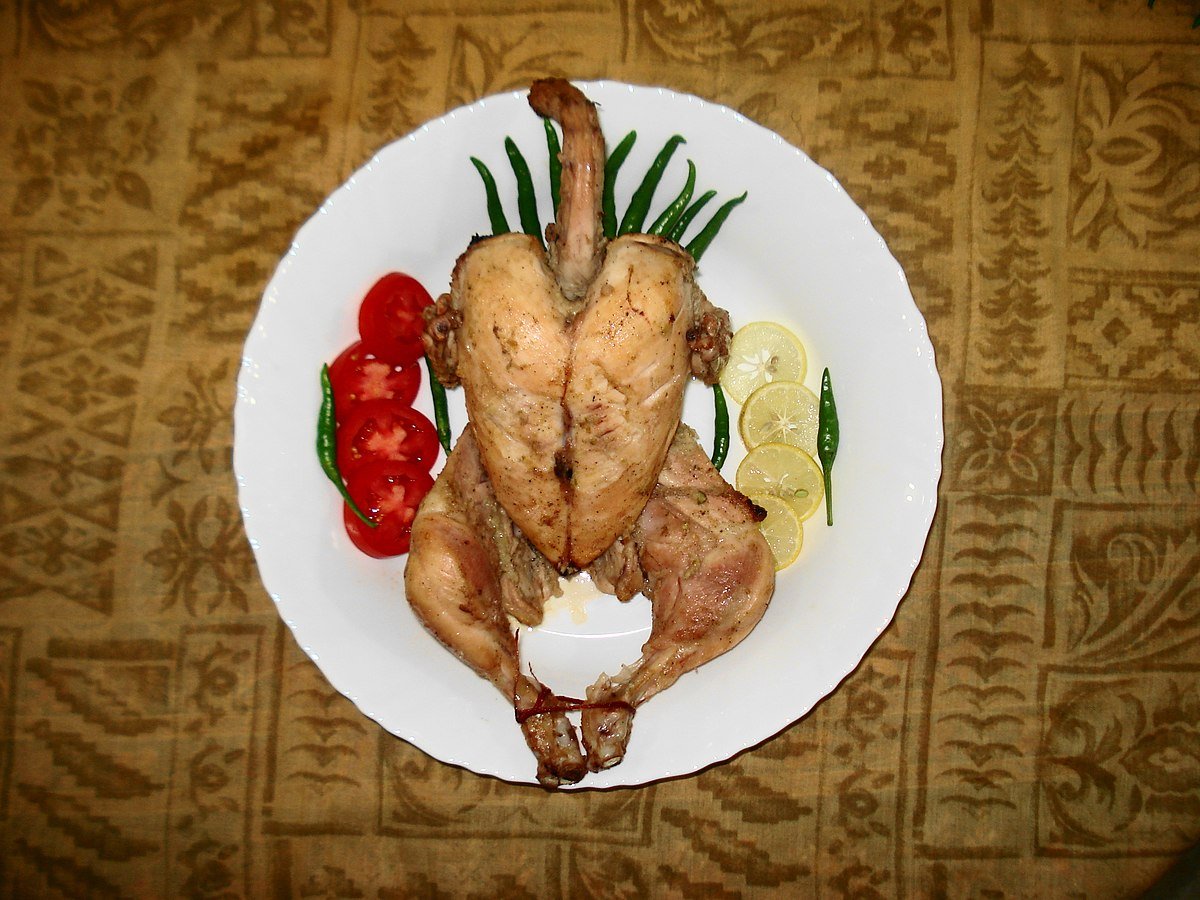Sajji

For the Marinade:
– 1 whole lamb or chicken (cleaned and gutted)
– 1 cup yogurt
– 1/4 cup lemon juice
– 1/4 cup vinegar
– 1/4 cup vegetable oil
– 2 tablespoons ginger-garlic paste
– 2 tablespoons papaya paste (or meat tenderizer)
– 2 tablespoons ground cumin
– 2 tablespoons ground coriander
– 1 tablespoon red chili powder
– 1 tablespoon turmeric powder
– 1 tablespoon garam masala
– Salt to taste
For Stuffing (Optional):
– 2 large onions, thinly sliced
– 2-3 green chilies, slit lengthwise
– Fresh coriander leaves
– Fresh mint leaves
– Whole spices (cinnamon stick, cardamom pods, cloves)
For Serving:
– Fresh naan bread or rice
– Mint yogurt sauce
– Sliced onions and lemon wedges
Instructions:
Step 1: It is recommended to marinate the meat for several hours before cooking because that will help the meat to absorb substantial amounts of marinade and flavorings.
1. In a large mixi bowl, thoroughly mix yogurt, lemon juice, vinegar, vegetable oil, ginger-garlic paste, papaya paste, ground cumin, ground coriander, red chili powder, turmeric powder, garam masala and as per your salt preference. Whisk together until the marinade is relatively homogeneous, with a liberal coating of glue-like appearance.
2. The deeper the cuts made on the either the lamb or chicken, the better the marinade is going to be absorbed into it.
3. Coat the marinade on the meat properly to ensure it gets into skin of the meat. Rub the marinade gently into the cuts to get a perfect marinade contact. Place the lid on the bowl and let it marble in the fridge for about 6-8 hours or ideally overnight.
Step 2: To prepare the stuffing, follow the given procedure:
1. Chop Onions and green chilies finely and combine them in a bowl; add fresh coriander leaves, mint leaves and mix the whole spices like cinnamon stick small cardamom and cloves.
2. After preparation of the stuffing, pack it into the cavity of the lamb orChicken.
Step 3: Sajji Delight:
1. It is pertinent to set the heat levels in the grill or oven to about medium-high.
2. For the use of a grill, arrange a rotating spit or skewers for roasting the meat. When using an oven place an instance on roasting rack with tray underneath it before putting it into the oven.
3. Grill the marinated lamb or chicken with the lid open for about 12-15 minutes, flipping from one side to the other to develop an equal amount of grill marks (don’t worry if there are a bit more on one side; the less-done side will not be exposed to the high heat of the grill). The possibility of using any leftover marinade or oil should be considered for basting the bird at appropriate intervals to retain moisture.
4. Fry the meat until cooked through and crispy on the skin outside while it should be pale and slightly glossy on the inside. This may take between 2 to 3 hours depending on the size of the meat being prepared and how it is being cooked.
Step 4: Sajji is to be served with the eyes and chin:
1. When the sajji is done and you notice that the ends of the bread are also toasted, the sajji should be transferred from the grill or oven to a plate and allowed to cool slightly.
2. Trim the fat and slice or cut the meat while still hot in portions to be served on a plate.
3. Serve hot with fresh naan bread or rice on the side, mint yogurt sauce, chopped onion and lemon wedges.
Enjoy your homemade sajji, a sweet and savory dish that your guests are sure to love!
Calories in Sajji:
Sajji is not just a snack; It is a cultural symbol deeply rooted in the history and traditions of the Baloch people, especially in the Balochistan province of Pakistan and parts of Iran and Afghanistan. Let’s dig deeper into the benefits and history of Saji:
History of Sajji:
Ancient Origins: This dish has its roots in the earlier decades in the 18th century among the Baloch peoples, which were acclaimed nomadic tribes. In the past, it was eaten by the Balochi tribesmen, who ate it when they when they were trekking across the rough terrains here. Due to its purpose of consumption by nomadic people, Sajji also lacks many ingredients in its preparation and has been cooked very simply.
Culinary Heritage: In due course of years, it turned into a part of staple diet of Balochi and changed from being the food which was prepared for survival to being treated as a luxury. It owns a special eat for the Balochi tribe and it is more like festive food that is prepared on the occasions like marriage ceremony, festivals etc where it is believed that food served is a symbol of welcome and abundance.
Traditional Cooking Methods: Originally, sajji is prepared roasting it on charcoals or in tandoorian means that involves direct grilling over a charcoal or a wood fire. This is usually made with whole goat or sheep meat or Even chicken prepared from a mixture of locally available spices and marination with acquisition to tasteful tenderness by roasting.
Benefits of Sajji:
Nutrient-Rich: The whole cuts of lamb or chicken used in preparing Sajji contain lean protein and are very rich in essential amino acids, B group of vitamins such as vitamin B12, and minerals like iron and zinc. Also, through slow roasting, the outcome is tender meals that maintain the juices and nutrients within the meat.
Minimal Ingredients: Just like other dishes of this region, Sajji is prepared from very simple additive; mainly meat, spices and flavoring agents. This helps to avoid masking the natural tastes of the meat and allows to get delicious as well as rather healthy dish.
Balanced Nutrition: Sajji could be classified as a high protein and fat meal with a good amount of carbohydrates, thus serves as a good food that is filling and nourishing. It provides long-lasting energy and supports satisfaction because of food intake, which makes it a perfect fit for those who have active live.
Cultural Significance: In addition to its nutritional value, sajji has cultural significance in the Balochi society. It symbolizes hospitality, kindness and communal eating, bringing people together to share in the joys of food and fellowship.
conclusion:
The history of Saji is linked with a rich fabric of Balochi culture and tradition. As a dish that has stood the test of time, it continues to be loved and celebrated by Balochis and food enthusiasts across the globe Whether enjoying a festive gathering or a casual dinner with loved ones , Sajji embodies the essence of Balochi hospitality and culinary heritage, making it timeless for generations to come. It’s a nice thing
The significance of Saji extends beyond its status as a culinary hobby; It has cultural, social and symbolic significance especially in the places where it is consumed. Here is a detailed account of how important Saji is:
1. Cultural Implications:
Cultural Identity: Sajji is deeply embedded in Baloch culture, especially in and around the Balochistan province of Pakistan. It represents a culinary tradition passed down through generations, reflecting the unique customs, values and way of life of the Balochi people.
Heritage and Tradition: Sajji is more than just a dish; It is a symbol of cultural heritage and tradition. The methods of preparation, choice of ingredients and cooking have not changed much over the years, preserving the integrity and authenticity of Balochi cuisine
2. Social Importance:
Community and shared space: Decorating is often popular at social events, festivals, weddings, and other special occasions. Its use creates a sense of unity, solidarity and friendship, bringing families, friends and communities closer together.
Hospitality and kindness: In Balochi culture, ready guests are considered as a symbol of hospitality and kindness. It reflects the host’s desire to welcome and respect their guests, ensuring that they have a delicious and memorable dining experience.
3. Symbols:
Festivities and Abundance: Often associated with festivals and feasts, sajji is a symbol of abundance, prosperity and happiness. When it comes to festivals, it signifies many blessings from the provision of food and nutrition to the community.
Cultural Pride: Sajji is a source of cultural pride for the Baloch people, serving as a tangible resource of their identity, history and heritage. Its decorations and feasting evoke feelings of nostalgia and pride, strengthening the bond between the Balochis and their culinary traditions.
4. Best Cooking:
Distinctive flavors and aromas: Sajji is known for its distinctive tastes and aromas, characterized by smoky, burnt notes delivered by traditional cooking methods with gently roasted meat delivery tender and juicy meat with plenty of spices and seasonings coming through.
Culinary skills: Making sajji requires skill, patience and culinary skills, enhancing its status as a culinary masterpiece From choosing the best cuts of meat to the finest spices , Sajji represents the pinnacle of Balochi cuisine
conclusion:
Sajji is not just a snack; It is a cultural organization that incorporates the Baloch spirit, traditions and values. Its significance transcends the culinary realm and symbolizes cultural pride, social harmony and culinary excellence. Whether enjoyed at festive celebrations or casual gatherings, Sajji holds a special place in the hearts and homes of Balochi communities, reaffirming its timeless importance for generations to come.
